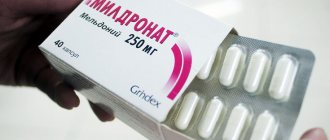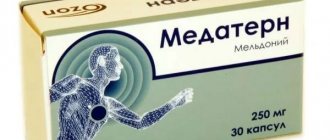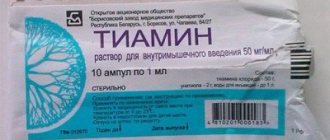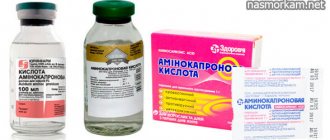To improve or maintain metabolism, as well as energy supply to all organs of the human body, experts prescribe Mildronate.
The good effect, as well as the few side effects of Mildronate, determine its popularity among almost all categories of the population.
Like any other drug, Mildronate should be prescribed by a doctor even in the absence of visible symptoms of the disease.
The active ingredient of the drug is meldonium, which leads to:
- to improve the body's performance;
- increasing humoral and tissue immunity;
- increasing human resistance to negative psychological and physiological factors;
- normalization of cardiac activity.
In addition, the product protects cells from destruction, removes toxic products and waste from cellular metabolism, and also helps to increase their stability. As a result, the increased metabolic rate leads to faster recovery of the body.
The drug's ability to optimize blood flow allows it to redirect blood flow to oxygen-starved areas of the heart, brain and eye. As a result, blood supply is normalized, the organ receives a sufficient amount of oxygen and necessary nutrients. This property of Mildronate is of particular relevance in ischemia.
The use of Mildronate leads to vasodilation and normalization of cellular immunity, as a result of which immunity in general improves.
The tonic effect on the somatic and autonomic nervous system leads to the elimination of physical and psychological disorders due to prolonged use of alcoholic beverages. Allows you to eliminate alcohol withdrawal, manifested in the form of tremors, memory loss, and obsessive states.
Among the most common indications for the use of Mildronate are:
- ischemia of the heart and brain;
- angina pectoris;
- heart attack;
- chronic heart failure;
- pain syndrome in the heart due to pathologies of the organ;
- dishormonal cardiomyopathy;
- impaired functioning of the cardiovascular system and neurocirculatory dystonia during puberty;
- pathological changes in the eyes;
- chronic obstructive pulmonary pathologies;
- psychological and physical consequences of long-term alcohol use;
- low performance;
- overstrain and fatigue.
Only a doctor can determine the need to use the drug
Application of Mildronate
Mildronate is recommended for the treatment of the following diseases in adults:
- Coronary artery disease – damage to the myocardium of the heart;
- Heart failure - impaired myocardial functionality;
- Overtraining syndrome in sports – the appearance of persistent pain;
- Increased mental stress, decreased concentration and memory;
- Hangover syndrome – the appearance of symptoms of alcohol withdrawal;
- Dysfunction of cerebral circulation;
- Decreased performance, chronic fatigue syndrome;
- Hemophthalmos - penetration of blood or blood clots into the vitreous body of the eye;
- Retinopathy is damage to the retina of the eye.
As a result of the action of Mildronate, blood circulation improves and myocardial contractility is normalized, therefore the drug is used in the complex therapy of cardiovascular diseases. In sports, Mildronate is taken by athletes to increase physical strength and improve metabolism.
Indications for use
Meldonium is prescribed as an additional therapy for serious diagnoses and certain conditions:
- cardiac ischemia;
- myocardial dysfunction;
- disruption of blood supply to the brain as a result of a stroke;
- rehabilitation period after surgical interventions;
- heavy physical activity;
- low performance, weakness and chronic fatigue;
- withdrawal syndrome in chronic alcoholism;
- dishormonal cardiomyopathy.
The drug is administered by injection through the skin of the lower eyelid for hemorrhages, circulatory disorders or thrombosis of the veins in the retina, pathologies of the fundus vessels, as well as for diabetic or hypertensive retinopathy.
Mildronate - a little history
Mildronate is also known as Meldonium. Actually, meldonium is the active ingredient of mildronate.
Meldonium was developed in the 1970s by Ivars Kalvins - then director of the Institute of Organic Synthesis of the Academy of Sciences of the Latvian SSR - one of the leading research institutes in this field in the USSR. It was his scientists who were instructed to make a “product for household use” from meldonium, which then had a military purpose.
Initially, the development was called “mildronate”. It was registered in 1976, and began to be used in 1984. On December 7, 2011, by order of the government of the Russian Federation, meldonium was included in the list of vital and essential drugs.
Since January 1, 2016, meldonium has been banned by the World Anti-Doping Agency (WADA) for use by athletes before and outside of competition. Then, many famous Russian athletes, for example, tennis player Maria Sharapova, were disqualified for using meldonium, although they claimed that they last took it in 2015. The international doping scandal was just beginning to gain momentum...
By the way, L-carnitine, a popular dietary supplement that is freely sold in many countries and is not on the list of prohibited drugs, has properties similar to meldonium.
Overdose and its consequences
Until now, there have been no reports of cases of overdose with Mildronate, since the drug is low-toxic and does not cause severe side effects. In case of poisoning with the drug, the following symptoms are possible: decreased blood pressure, headache, palpitations, general weakness.
In cases of severe poisoning, liver and kidney dysfunction may occur. Treatment of poisoning is symptomatic. Hemodialysis is ineffective due to the high degree of binding of the drug to plasma proteins.
How Mildronate works
The active substance meldonium, acting in several directions at once, establishes a balance between the cells’ need for oxygen and its delivery, removes accumulated toxins and neutralizes their negative impact on the body. Thanks to this, a person taking Mildronate becomes more resilient to mental and physical stress and gets an improved metabolism.
Other results of using Mildronate:
- normalization of cerebral circulation;
- improvement of blood circulation in the area of ischemia;
- slowing down the formation of the necrotic zone;
- elimination of functional disorders of the nervous system;
- reduction of the rehabilitation period in the treatment of heart disease, stroke and alcoholism
Mildronate is easily absorbed and excreted from the body after 3-6 hours. Although traces of it can still be found for several months.
Effect of the drug
Meldonium improves metabolic processes in the heart muscle and provides energy to the myocardium, as well as:
- improves blood circulation in the brain;
- normalizes the inflow and outflow of blood in areas with insufficient blood supply;
- slows down the formation of a zone of tissue death;
- brings myocardial performance indicators back to normal;
- provides brain and heart cells with oxygen;
- removes toxins;
- normalizes the functioning of the nervous system;
- shortens the rehabilitation period after heart surgery or stroke;
- helps in the treatment of alcoholism.
Use of Mildronate in sports
Mildronate is highly valued by athletes for its ability to improve cellular metabolism, as it accelerates the removal of toxins and free radicals from the body. Thus, Mildronate has an antioxidant effect: it improves well-being, slows down the aging process of cells and helps rapid muscle recovery.
Athletes take the drug to reduce pain and recover faster after training. As a result of taking Mildronate, symptoms of overtraining are relieved and fatigue goes away. The athlete’s general condition improves, which can affect his personal performance.
The benefits of the drug are difficult to overestimate during periods of intense physical activity, when training goes on almost without a break, for example, before a competition, and the body does not have time to rest.
Mildronate is recommended to be taken for up to 6 weeks without a break, so as not to cause addiction to the drug. To obtain good results, taking Mildronate should be combined with proper nutrition and daily routine.
Reviews
Sergey, 28 years old, Bryansk I couldn’t get rid of excess weight. It was impossible to play sports regularly. A few light workouts a week in the form of jogging was all I was capable of due to my laziness and obesity. A friend, a professional athlete, advised me to drink Mildronate. Activity has increased. I started running every morning and regularly visiting the gym. As a result, I lost 15 kg, got rid of my complexes, and found my girlfriend. Thanks to the drug.
Elena, 32 years old, Belgorod I try to keep myself in good shape. Not professionally, but I do sports, and at the same time I drink Mildronate. After taking the drug again, I went to my dad’s birthday party and drank a small amount of alcohol. The heart began to beat very quickly, the parents got scared and called an ambulance. The doctors explained that these were side effects of the drug used.
Vladislav Petrovich, general surgeon, Samara I prescribe this medicine in combination with other drugs to patients in the postoperative period, after consulting with a cardiologist. Contraindications to the use of Mildronate are minimal, and the duration of rehabilitation is significantly reduced.
Composition of Mildronate and release forms
The composition may vary depending on the form of release.
- Mildronate ampoules contain meldonium and water for injection.
One ampoule contains 5 ml of the drug, which contains 250 mg of the active substance. Available in cardboard packaging of 10 ampoules.
- Mildronate capsules:
- meldonium;
- potato starch;
- calcium stearate;
- colloidal silicon dioxide;
- titanium dioxide and gelatin in the shell.
Capsules come in two types: with 250 mg and 500 mg of active substance. Sold in cardboard packs of 40 and 60 pieces.
- Mildronate in syrup:
- meldonium;
- purified water;
- cherry essence;
- glycerol;
- dyes;
- propylene glycol.
Two packaging: 150 ml and 250 ml. 5 ml (one dose) of the medicine contains 250 mg of the active substance. Available in cardboard packaging with a 5 ml measuring spoon.
Mildronate enters the blood most quickly in ampoules, immediately after administration of the drug. The syrup also has a good absorption rate. But capsules are more convenient to take.
pharmachologic effect
- Mildronate acts as an angioprotector: dilates blood vessels, reduces tissue swelling, stimulates metabolism in cells, restores blood composition;
- Cardioprotector: strengthens the heart, accelerates cell regeneration, removes toxins;
- The drug has an antihypoxic effect: reduces tissue oxygen demand, activates cellular metabolism, stimulates regeneration, improves tissue nutrition;
- Antianginal effect: prevents and relieves attacks of angina, transports oxygen to the myocardium.
The high effectiveness of Mildronate is the result of a complex effect on the body. The particular benefits of the drug are often discussed by athletes who note an improvement in metabolic processes after its use.
Instructions for taking Mildronate
You can take the drug only on the recommendation of a doctor. As a rule, in the first half of the day, as it has a tonic and stimulating effect. Dosage and rules differ depending on the release form.
Capsules
Reception depends on the purpose.
- For the treatment of cardiovascular diseases in complex therapy, take 0.5-1 grams per day for up to 6 weeks. 250 mg capsules are taken up to 4 per day, 500 mg tablets - up to 2 per day. The daily dose should be divided into 1-2 doses.
- For the treatment of chronic dysfunctions of cerebral circulation, the dosage is the same. During the year, no more than 2 courses lasting up to 6 weeks each.
- For the treatment of chronic alcoholism and detoxification, take 500 mg 4 times a day. The duration of therapy reaches 10 days.
- To increase endurance and physical strength, athletes take 1-2 capsules twice a day before training. Duration of treatment is 21 days, during competitions – up to 14 days.
To make swallowing easier, drink with water.
Syrup
- For the treatment of heart diseases and deterioration of cerebral circulation, take 1 scoop of syrup twice a day.
- The dosage for athletes is selected individually, based on the daily norm of 1 gram (4 scoops), divided into two doses.
Ampoules
The solution in ampoules is administered intravenously, intramuscularly and by injection into the eye.
- Diseases of the heart and brain: 2 ampoules into a vein per day, 1 ampoule 2 times. The course is from 4 to 6 weeks.
- Chronic alogolism: 1 gram per day for 10 days intravenously or intramuscularly.
- Athletes need to administer 500 mg intravenously once, up to 3 weeks.
- Diseases of the retina: eye injection of 0.5 ml of solution per day, up to 10 days.
But why do athletes use it?
Unfortunately, elite sport is rarely combined with the concept of “health”. With prolonged work in the maximum and submaximal heart rate zone, a condition called “diastolic dysfunction” develops, the essence of which is a shortening of diastole, that is, the rest period between contractions. As a result, the chambers of the heart are not filled with enough blood and the stroke volume of the heart decreases, therefore less blood reaches the organs and tissues.
Insufficient blood flow through the coronaries leads to inadequate oxygen supply to the myocardium, resulting in fibrosis.
Mildronate , having a cardioprotective effect, allows you to slow down this process , and in the conditions of an existing problem, train the body to make the most efficient use of the resources it has in the current situation and, accordingly, obtain the maximum result. But all this is part of a comprehensive treatment.
Therefore, there can be only one conclusion. Any medication use must be justified by the clinical situation and the purpose of treatment, which a specialist can determine!
Contraindications, side effects, overdose
Mildronate is prohibited for use:
- Under the age of 18;
- Pregnant and breastfeeding;
- With increased intracranial pressure;
- With a brain tumor;
- If you are sensitive to substances contained in the drug.
The drug is strictly contraindicated in liver failure. In chronic forms of diseases, it can be taken for a short period and after the course, an examination can be carried out in case of complications.
Acute renal failure is noted as a contraindication. In case of chronic kidney disease, the drug should be taken for a long time with caution, monitoring the condition of this organ. Clinical studies of the drug's effects on the kidneys have not been conducted.
It is also not recommended to combine Mildronate with drinking alcohol. You can drink alcohol 12 hours after taking the drug so that the active substance is removed from the body.
Side effects are observed either due to individual intolerance to the components of the drug, or when taken incorrectly. Among them:
- skin rashes;
- malaise;
- decrease or increase in blood pressure values;
- excitability;
- diarrhea.
If any disturbances are observed, you should consult a doctor and possibly change your therapy.
Keep in mind that tachycardia is possible when taking Mildronate simultaneously with nitroglycerin and nifedipine or antihypertensive drugs. In general, Mildronate combines well with other medications, especially with drugs against pulmonary diseases and arrhythmia.
There is also no data on the adverse effects of the drug in case of overdose. But it is better to rinse your stomach and consult a doctor.
Mildronate is well tolerated by the body without causing toxicity. Rarely, increased blood pressure, tachycardia, nausea, and weakness are possible.
Store the drug at a temperature not exceeding 25 degrees Celsius and out of the reach of children.
special instructions
When used together, it enhances the effect of drugs that dilate blood vessels and reduce the heart's need for oxygen, as well as drugs that normalize myocardial function and restore metabolism. Concomitant use with alcohol is not recommended (it is necessary to wait 12 hours between doses).
The medicine has mild toxicity and in case of overdose, symptomatic treatment is carried out.
Prescribed with caution for liver and kidney diseases. In case of an acute heart attack, Meldonium is not the first-line drug of choice. It is not recommended to take it without a doctor's prescription.
Mildronate. Analogs, prices
There are many analogues of Mildronate on the market; if a replacement is necessary, your doctor will help you make a choice.
- Vasomag - from 200 rubles;
- Cardionate – from 170 rubles;
- Meldonium - from 230 rubles.
- Melfort - from 500 rubles;
- Midolat - from 128 rubles;
- Metonate – from 300 rubles;
- Riboxin - from 37 rubles.
The cost of the drug depends on its release form and region. For example, prices in Moscow:
- ampoules – from 417 rubles;
- syrup - from 300 rubles.
- Capsules - from 300-550 rubles.
Price, reviews, analogues
The price of Meldonium depends on the number of capsules in the package and the concentration of the main substance. The price for a package of 30 pieces with a dosage of 250 mg costs from 170 rubles, 60 pieces - from 320 rubles, 60 pieces with a dosage of 500 mg - from 550 rubles.
Structural analogues of Meldonium are Mildronate, Idrinol, Cardionate.
Reviews of Meldonia from doctors are generally positive. The drug has shown effectiveness in the treatment of withdrawal symptoms and cardiac pathologies, is well tolerated by patients and increases endurance.
Patients note a surge of strength and faster recovery after training, but it is not recommended to use it in the treatment of diseases of the cardiovascular system without a doctor’s prescription.









